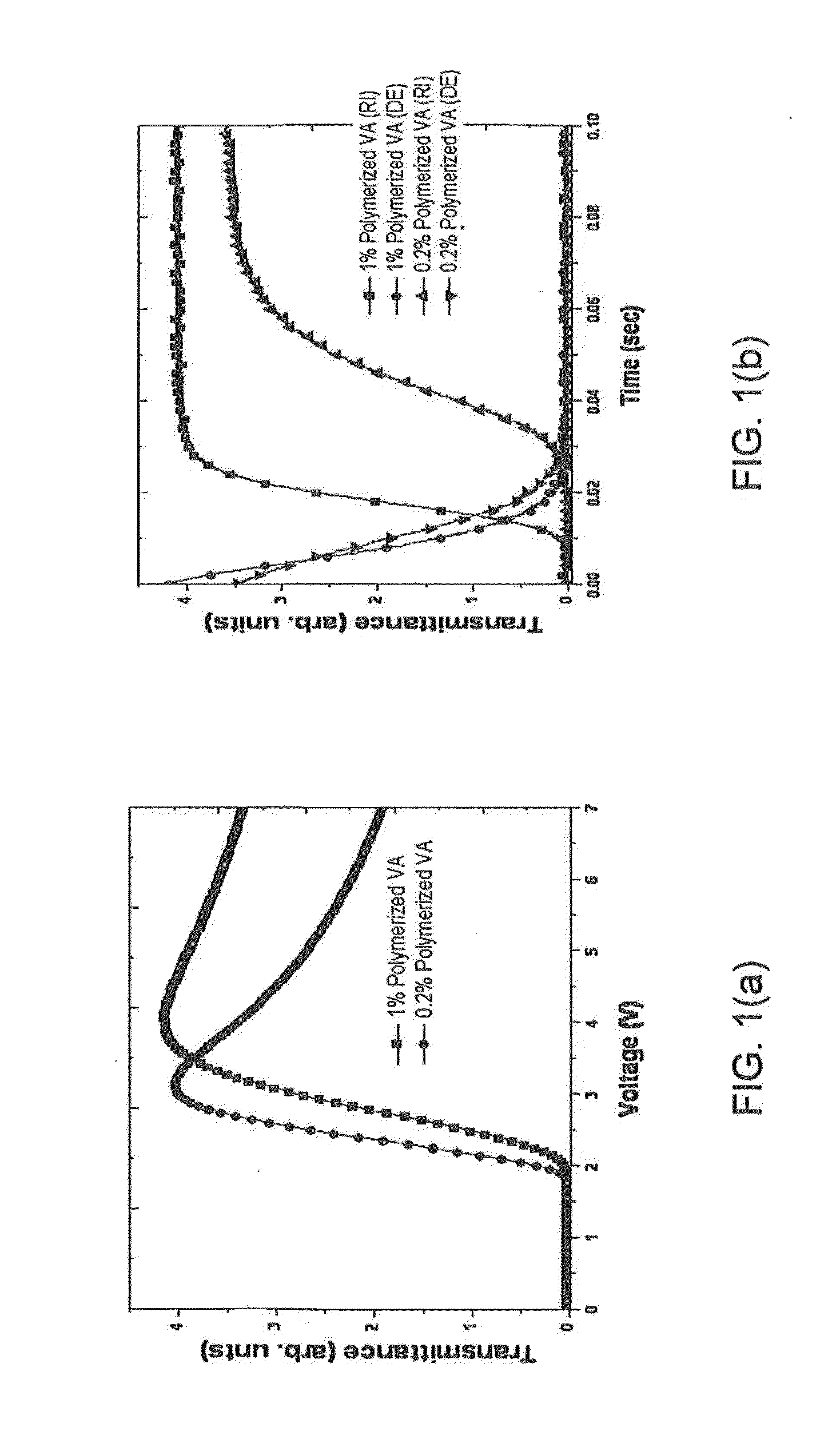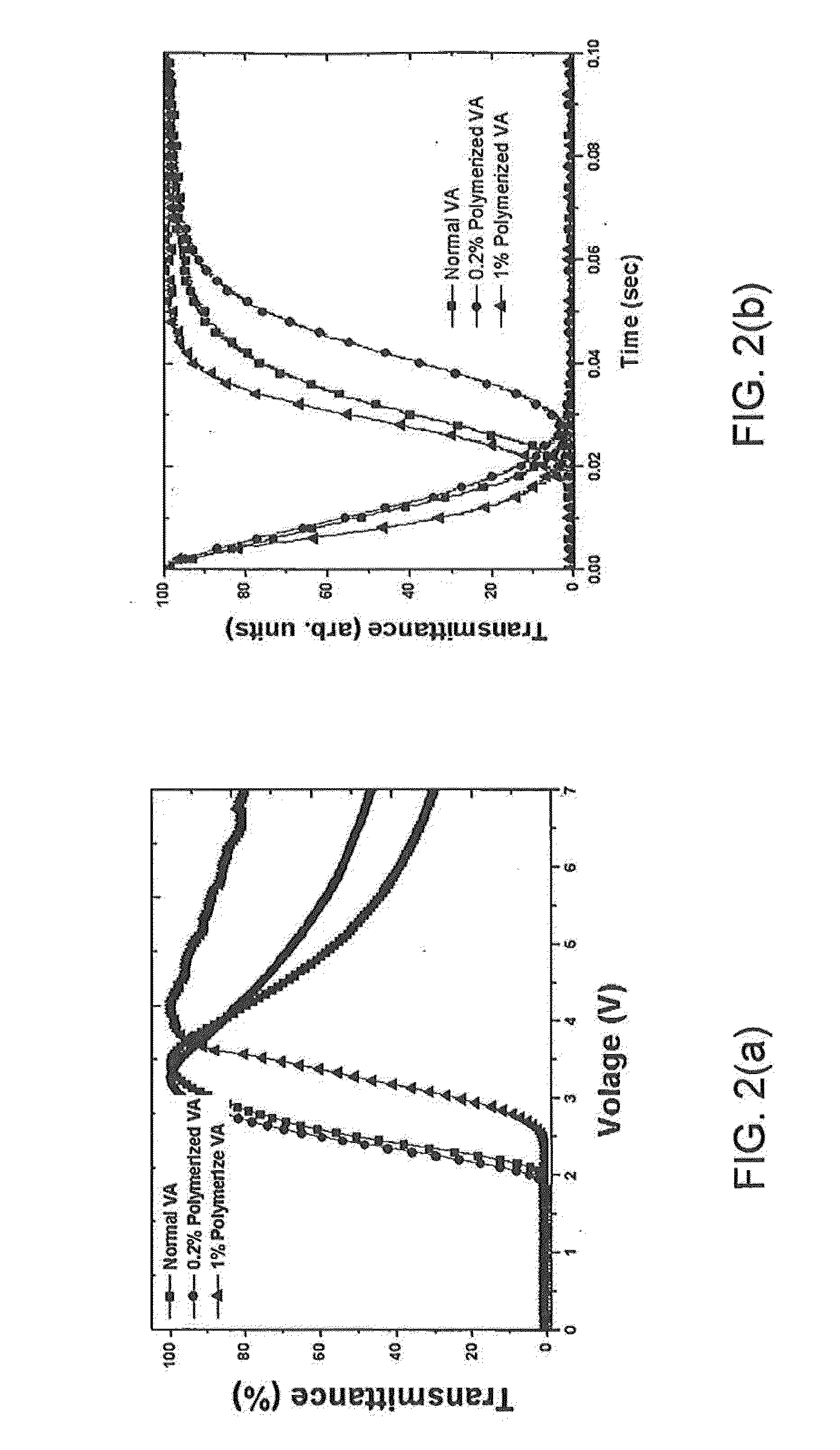Fast-switching surface-stabilized liquid crystal cells
a liquid crystal cell, fast technology, applied in liquid crystal compositions, instruments, chemistry apparatus and processes, etc., can solve the problems of insufficient speed, insufficient motion picture in lcd tv, blur of lcds using nematic liquid crystal, etc., to improve the response time, improve the switching time, and enhance the effect of liquid crystal surface anchoring
- Summary
- Abstract
- Description
- Claims
- Application Information
AI Technical Summary
Benefits of technology
Problems solved by technology
Method used
Image
Examples
example 1
Double Side UV Exposure Samples
[0029]Samples were prepare by dissolving 2.99 wt. % concentration of monomer RM 257 and a small amount 0.08 at % of photoinitiator Irgacure 651 into a common liquid crystal solvent ZLI-4788-000 (Merck). This experiment was reproduced again for Sample 2′ with the following composition: 2.98 wt % of RM257, 0.08 wt % of Irgacure 651 and 96.94 wt % of ZLI-4788-000. This liquid crystal has a negative dielectric anisotropy Δε=−5.7 (at 20° C., and f=1 kHz). Table 1 shows a typical composition of the mixture for preparation of SPA-VA LC cells. This liquid crystal has a negative dielectric anisotropy Δε=−5.7 (at 20° C., and f=1 kHz). To effectively induce a vertical alignment with controllable tilt angle, the monomer may consist of a mixture of a mono-polymerizable monomer with a long side chain (selected from linear or branched hydrocarbon or perfluorinated side chain with carbon number from 5 to 20) and a reactive monomer at appropriate concentration. For exa...
example 2
Single-Side UV Exposure with a Reflector
[0036]Materials and Process. Two samples were prepared for single-side UV exposure by mixing monomer RM257, photoiniator Irgacure 651 and liquid crystal ZLI-4788-000 at the ratios of 0.2% / 0.03% / 99.77% and 1.0% / 0.05% / 98.95%, respective. These materials were mixed by adding a few drops of organic solvent dichloromethane to dissolve the solid, and the solvent was subsequently evaporated under a stream of nitrogen gas and house vacuum to remove the residual solvent. The mixture was loaded into cells by which the glass substrates were spin-coated with a polyimide solution (Nissan Chemical SE 1211), pre-baked at 80° C. for 5 minutes then cured for one hour at 180° C., and later buffed uni-directionally to introduce a small antiparallel pretilt of the homeotropic boundary conditions. Glass bead spacers were sprayed between the substrates to maintain uniform cell gaps of 3.5 and 3.6 micron. The cells were filled with the liquid crystal / polymer mixture...
example 3
Dual UV Lamps Exposure
[0038]Materials and Process. Two samples were prepared for single-side UV exposure by mixing monomer RM257, photoiniator Irgacure 651 and liquid crystal ZLI-4788-000 at the ratios of 0.2% / 0.03% / 99.77% and 1.0% / 0.05% / 98.95%, respective. These materials were mixed by adding a few drops of organic solvent dichloromethane to dissolve the solid, and the solvent was subsequently evaporated under a stream of nitrogen gas and house vacuum to remove the residual solvent. The mixture was loaded into cells by which the glass substrates were spin-coated with a polyimide solution (Nissan Chemical SE 1211), pre-baked at 80° C. for 5 minutes then cured for one hour at 180° C., and later buffed uni-directionally to introduce a small antiparallel pretilt of the homeotropic boundary conditions. Glass bead spacers were sprayed between the substrates to maintain uniform cell gaps of 3.5 and 3.6 micron. The cells were filled with the liquid crystal / polymer mixtures and then exposed...
PUM
| Property | Measurement | Unit |
|---|---|---|
| height | aaaaa | aaaaa |
| diameter | aaaaa | aaaaa |
| height | aaaaa | aaaaa |
Abstract
Description
Claims
Application Information
 Login to View More
Login to View More - R&D
- Intellectual Property
- Life Sciences
- Materials
- Tech Scout
- Unparalleled Data Quality
- Higher Quality Content
- 60% Fewer Hallucinations
Browse by: Latest US Patents, China's latest patents, Technical Efficacy Thesaurus, Application Domain, Technology Topic, Popular Technical Reports.
© 2025 PatSnap. All rights reserved.Legal|Privacy policy|Modern Slavery Act Transparency Statement|Sitemap|About US| Contact US: help@patsnap.com



